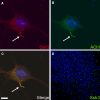Neuronal ciliary signaling in homeostasis and disease
- PMID: 20544253
- PMCID: PMC3349968
- DOI: 10.1007/s00018-010-0425-4
Neuronal ciliary signaling in homeostasis and disease
Abstract
Primary cilia are a class of cilia that are typically solitary, immotile appendages present on nearly every mammalian cell type. Primary cilia are believed to perform specialized sensory and signaling functions that are important for normal development and cellular homeostasis. Indeed, primary cilia dysfunction is now linked to numerous human diseases and genetic disorders. Collectively, primary cilia disorders are termed as ciliopathies and present with a wide range of clinical features, including cystic kidney disease, retinal degeneration, obesity, polydactyly, anosmia, intellectual disability, and brain malformations. Although significant progress has been made in elucidating the functions of primary cilia on some cell types, the precise functions of most primary cilia remain unknown. This is particularly true for primary cilia on neurons throughout the mammalian brain. This review will introduce primary cilia and ciliary signaling pathways with a focus on neuronal cilia and their putative functions and roles in human diseases.
Figures




References
-
- Nonaka S, Tanaka Y, Okada Y, Takeda S, Harada A, Kanai Y, Kido M, Hirokawa N. Randomization of left–right asymmetry due to loss of nodal cilia generating leftward flow of extraembryonic fluid in mice lacking KIF3B motor protein. Cell. 1998;95:829–837. doi: 10.1016/S0092-8674(00)81705-5. - DOI - PubMed
Publication types
MeSH terms
Grants and funding
LinkOut - more resources
Full Text Sources

